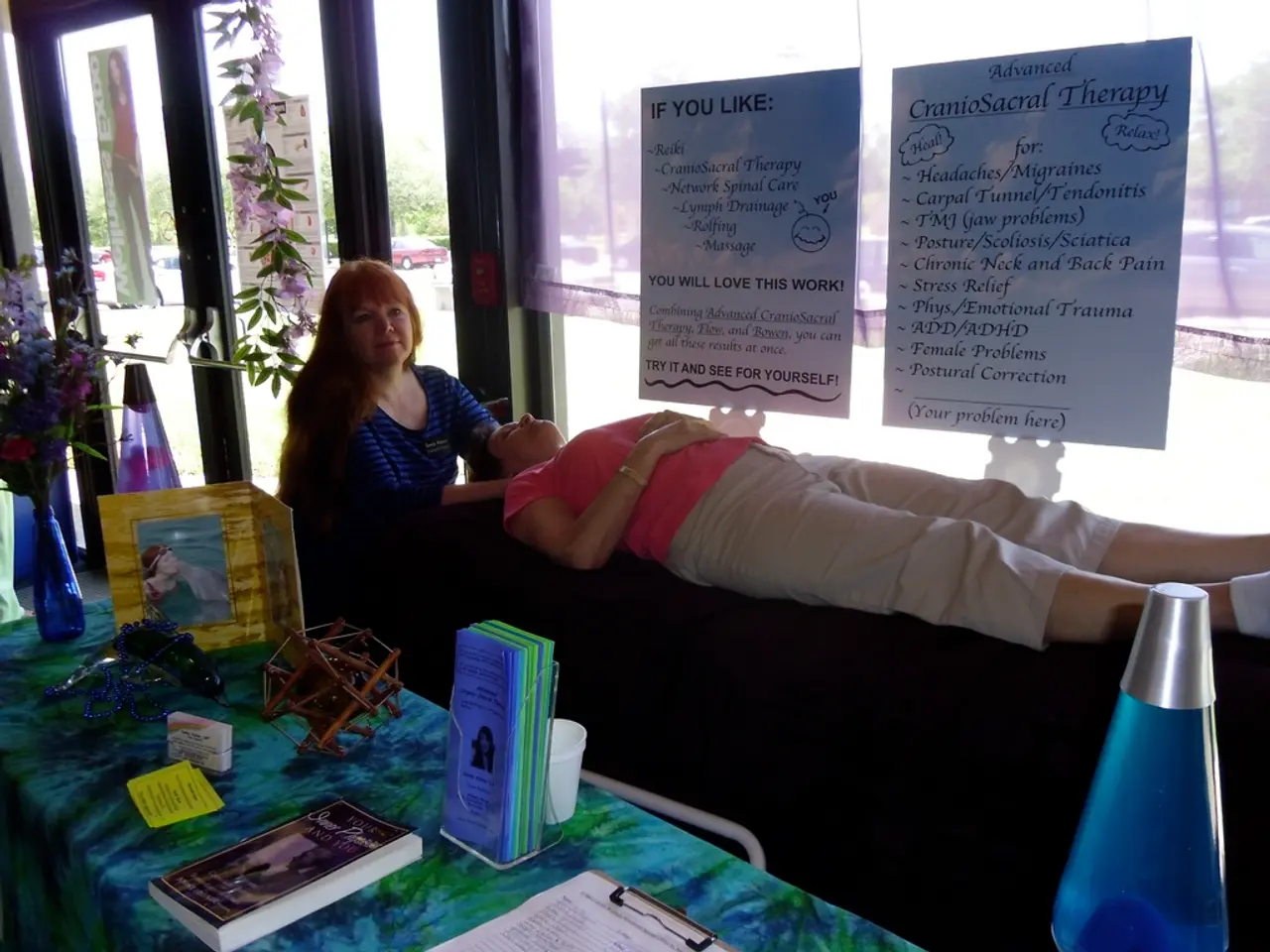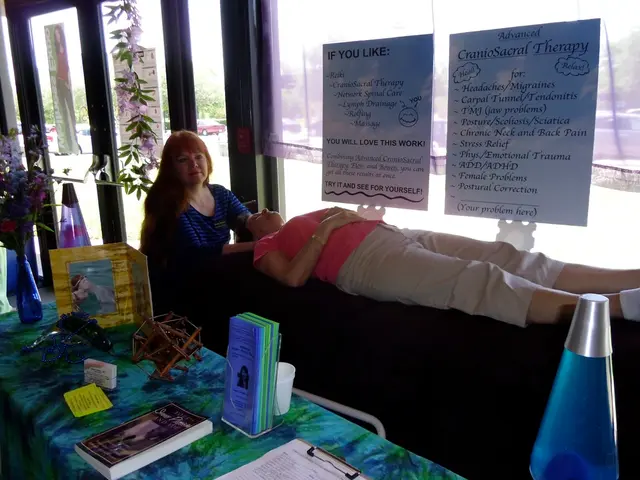Back discomfort while reclining: Origins and remedies
Struggling with Lower Back Pain? Here's What You Need to Know
Lower back pain can be a persistent and bothersome issue for many, affecting daily activities and sleep. This article aims to provide an overview of common causes and treatments for lower back pain that worsens when lying down.
Common Causes
Several factors can contribute to lower back pain, and understanding these can help in finding effective solutions.
Sleep Posture
Poor sleeping positions, such as sleeping on your stomach, can exacerbate lower back pain due to the lack of support for the spine, leading to strain and discomfort. Gravity shift, when lying down, can also redistribute weight, increasing pressure on inflamed nerves, particularly problematic for conditions like sciatica.
Underlying Conditions
Herniated or bulging discs, arthritis, osteoporosis, and spinal stenosis are common conditions that can lead to chronic lower back pain. Muscle strain from improper lifting or awkward movements can also cause pain that worsens when lying down.
Other Factors
Poor mattress support, lifestyle factors, and poor posture can contribute to back pain. An unsupportive mattress can misalign the spine and hips, leading to increased pressure and pain. Prolonged sitting or standing can also strain the back muscles, contributing to back pain.
Treatments
Non-Invasive Methods
Adjusting sleep position, gentle exercises, stretching, and heat or cold therapy can help manage lower back pain. Sleeping on your side with a pillow between your knees or on your back with a pillow under your knees can help maintain spinal alignment and reduce pressure. Exercise and stretching can help strengthen back muscles and improve flexibility. Heat or cold packs can help relax muscles and reduce inflammation.
Medical Interventions
Pain relievers like NSAIDs or muscle relaxants may be prescribed to manage pain and inflammation. Physiotherapy, tailored exercises, and therapy can help strengthen muscles and improve posture. In some cases, corticosteroid injections may be used to alleviate nerve compression.
Advanced Treatments
Chiropractic care can help reduce nerve compression and improve spinal alignment. Surgical options, such as spinal fusion, discectomy, or laminectomy, are reserved for severe cases, such as spinal fractures or severe disc herniation.
Remember, addressing the underlying cause and adopting supportive sleep practices are crucial in managing lower back pain that worsens when lying down. If your back pain worsens in a particular position or when lying down, it is important to speak with a doctor as it could indicate a more serious spinal problem.
Common causes of lower back pain include muscle strains or sprains, ankylosing spondylitis, spinal stenosis, spinal tumors, fractures, osteoarthritis, sciatica, traumatic injury, and scoliosis. Treatment for each condition varies, but understanding the causes can help in finding the right solution for you.
- Understanding the causes of lower back pain can help in finding effective solutions.
- Poor sleeping positions, like sleeping on your stomach, can exacerbate lower back pain.
- Gravity shift when lying down can redistribute weight, increasing pressure on inflamed nerves, particularly for conditions like sciatica.
- Herniated or bulging discs, arthritis, osteoporosis, and spinal stenosis are common conditions that can lead to chronic lower back pain.
- Muscle strain from improper lifting or awkward movements can cause back pain that worsens when lying down.
- Poor mattress support can misalign the spine and hips, leading to increased pressure and pain.
- Prolonged sitting or standing can also strain the back muscles, contributing to back pain.
- Adjusting sleep position can help manage lower back pain.
- Sleeping on your side with a pillow between your knees or on your back with a pillow under your knees can help maintain spinal alignment.
- Exercise and stretching can help strengthen back muscles and improve flexibility.
- Heat or cold packs can help relax muscles and reduce inflammation.
- Pain relievers like NSAIDs or muscle relaxants may be prescribed to manage pain and inflammation.
- Physiotherapy, tailored exercises, and therapy can help strengthen muscles and improve posture.
- Corticosteroid injections may be used to alleviate nerve compression.
- Chiropractic care can help reduce nerve compression and improve spinal alignment.
- Surgical options, such as spinal fusion, discectomy, or laminectomy, are reserved for severe cases.
- Addressing the underlying cause and adopting supportive sleep practices are crucial in managing lower back pain.
- If your back pain worsens in a particular position or when lying down, it could indicate a more serious spinal problem.
- Common causes of lower back pain include muscle strains or sprains, ankylosing spondylitis, spinal stenosis, spinal tumors, fractures, osteoarthritis, sciatica, traumatic injury, and scoliosis.
- Treatment for each condition varies, but understanding the causes can help in finding the right solution.
- Obesity is a predictive factor for various chronic diseases, including diabetes, cardiovascular disease, and degenerative joint disorders like osteoarthritis.
- Science has shown that regular exercise, including muscle pain exercises, weight-management programs, and fitness and exercise routines, can help manage obesity and its related health issues.
- Autoimmune disorders such as lupus, rheumatoid arthritis, and multiple sclerosis can cause joint pain, fatigue, depression, and other symptoms.
- Medications, therapies, and treatments can help manage symptoms and improve quality of life for those with autoimmune disorders.
- Ankylosing spondylitis, a type of spondylitis, is a form of inflammatory arthritis that primarily affects the spine and sacroiliac joints, causing chronic back pain and stiffness.
- Diabetes, a chronic disease that affects the body's ability to process sugar, can lead to complications like nerve damage, kidney disease, and cardiovascular disease.
- Maintaining good diabetes management, including diet, exercise, and medication, can help prevent and manage these complications.
- Sclerosis, a neurological disorder, can cause problems with movement, balance, and vision.
- Multiple sclerosis, a type of sclerosis, affects the nervous system and can cause a wide range of symptoms, from vision problems to muscle weakness and paralysis.
- Crohn's disease, a form of inflammatory bowel disease, causes chronic inflammation in the digestive tract, leading to symptoms like abdominal pain, diarrhea, and weight loss.
- Depression, a mental health disorder, can cause persistent feelings of sadness, hopelessness, and loss of interest in activities.
- Seeking help from a mental health professional can help manage depression and improve quality of life.
- Aging can lead to various chronic diseases, such as osteoarthritis, heart disease, and Alzheimer's disease.
- Regular exercise, good nutrition, and routine health screenings can help in preventing and managing age-related diseases.
- Alzheimer's disease is a progressive neurological disorder that affects memory, thinking, and behavior.
- Early diagnosis and treatment can help slow the progression of Alzheimer's disease.
- Workplace wellness programs, including stress management techniques, healthy eating options, and exercise opportunities, can help employees manage chronic diseases and improve productivity.
- Understanding medical conditions such as these can help in making informed decisions about health and wellness, from managing chronic diseases like obesity and diabetes to seeking help for mental health disorders and neurological conditions.




